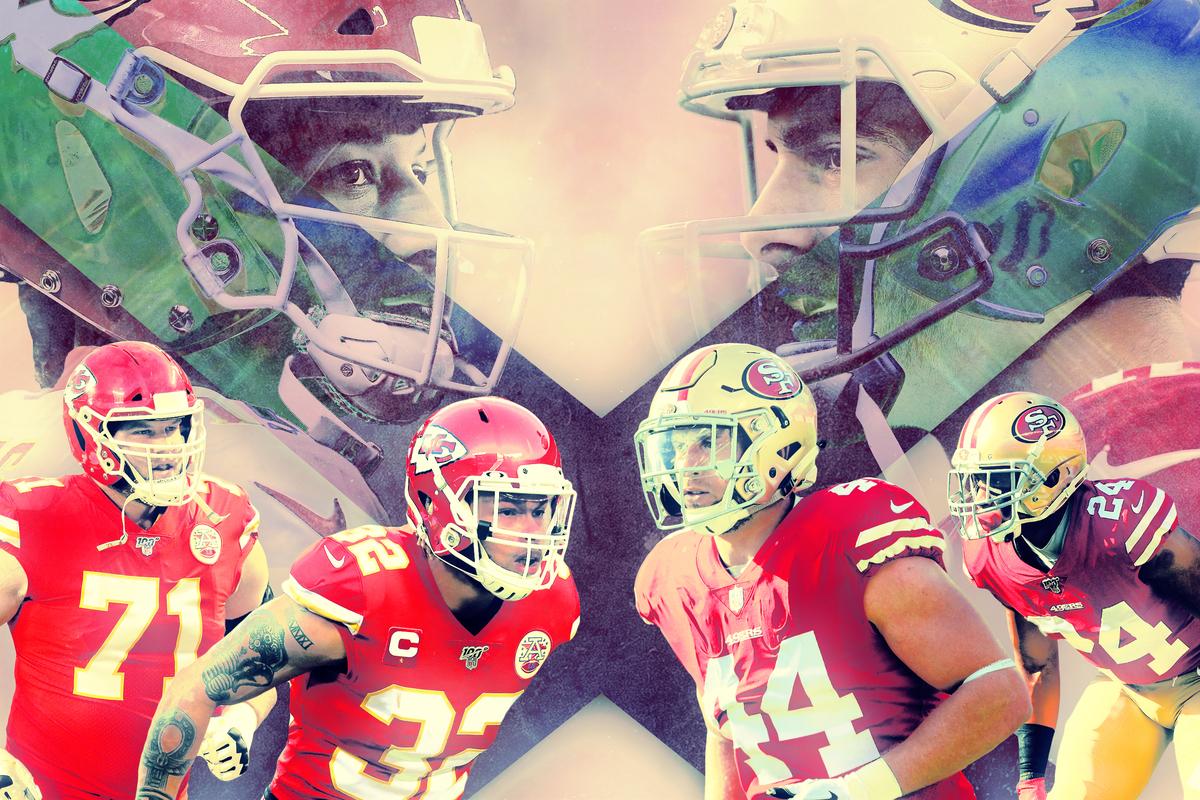
With a week left before Super Bowl LIV, there will be a lot of content about superstars Patrick Mahomes, Jimmy Garoppolo, Travis Kelce, George Kittle, and Richard Sherman. This piece is not about those guys. This is about the less publicized but still crucial players who will start but not star on Sunday. Past Super Bowls have often quietly come down to players like these. Patriots cornerback Jason McCourty broke up a Rams touchdown that could have changed the Super Bowl last year. Eagles defensive end Brandon Graham beat Patriots guard Shaq Mason for the game-clinching sack-fumble the year before. Patriots linebacker Dont’a Hightower tackled Marshawn Lynch the play before Malcolm Butler’s famous interception. Oftentimes it’s the players around the stars who determine the outcome of the game. With that in mind, let’s look at six not-so-famous X factors who could play a big role in Super Bowl LIV.
1. Kansas City Chiefs Left Tackle Eric Fisher and Right Tackle Mitchell Schwartz
If Patrick Mahomes is the most important player in Super Bowl LIV, then Fisher and Schwartz are the second- and third-most important people in the game. The 49ers will try to get their two best pass rushers, defensive ends Nick Bosa and Dee Ford, into one-on-one matchups with Fisher and Schwartz in passing situations, especially on third down. Schwartz is no slouch. Of the 32 offensive tackles who played at least 900 snaps this season, he tied for the third fewest allowed pressures (20) and was the only tackle not credited with allowing a sack in the regular season or first three rounds of the playoffs.
Schwartz’s primary concern on Sunday will be taking on Dee Ford on third down. Kansas City traded Ford to San Francisco for a second-round pick last March, and while Ford has been excellent when on the field for the 49ers, he missed five games this season with a hamstring injury. Even when he has played, he has mostly been limited to passing situations. The NFC championship game against the Packers was the first time Ford played more than half of the 49ers’ defensive snaps since Week 1. When Ford isn’t on the field, Schwartz may see a lot of 2015 first-round pick Arik Armstead, who has played more than half of his snaps as a left end over the right tackle. Armstead was the fourth-highest-graded edge defender among the 136 edge defenders who played at least 150 snaps this year, according to PFF. Whether Schwartz is facing Armstead on first and second down or Ford on third down, he’ll have perhaps his toughest game of the season on Sunday.
While Schwartz handles right tackle, Fisher will protect Mahomes’s blind side. Fisher missed only two games from 2013 through 2018, but he missed eight games this season after surgery to repair a core muscle injury in September. Since returning, Fisher has been a solid but not great tackle. Of the 63 tackles to play 200 snaps since Week 11, Fisher is the 32nd-highest-graded pass blocker by PFF, or almost exactly average. He’ll primarily line up against Nick Bosa, the likely Defensive Rookie of the Year winner.
2. San Francisco Cornerbacks Emmanuel Moseley and K’Waun Williams
The 49ers defense dominated the Packers in the NFC championship game, but the Chiefs present an entirely different challenge. Here are where the Packers receivers rank in a pre-draft 40-yard dash time, with their percentile rank at their position per Player Profiler.
WR Davante Adams: 4.56 seconds (45th percentile among receivers)
WR Allen Lazard: 4.55 seconds (49th percentile)
WR Geronimo Allison: 4.67 seconds (13th percentile)
WR Jake Kumerow: 4.58 seconds (37th percentile)
RB Aaron Jones: 4.56 seconds (61st percentile among running backs)
TE Jimmy Graham: 4.56 seconds (94th percentile among tight ends)
Here are Kansas City’s numbers.
WR Tyreek Hill: 4.34 seconds (98th percentile)
WR Sammy Watkins: 4.43 seconds (86th percentile)
WR Mecole Hardman: 4.33 seconds (99th percentile)
WR Demarcus Robinson: 4.59 seconds (34th percentile)
RB Damien Williams: 4.45 seconds (91st percentile)
TE Travis Kelce: 4.66 seconds (81st percentile)
The 40-yard dash is not the best barometer of athleticism, but the difference between the Packers and Chiefs receivers is stark. The Packers don’t have one wide receiver with above-average speed. The Chiefs might have the two fastest players in the NFL at any position. That speed is difficult for any team to face, and it will be the main challenge for San Francisco’s secondary in the Super Bowl. Just about every football fan knows Richard Sherman, the 49ers’ no. 1 cornerback. Fewer know the no. 2 and no. 3 cornerbacks who will be on the field on Sunday. While Sherman plays almost exclusively on the left side of the field (from the defensive perspective, the quarterback looks to his right to see Sherman), Moseley plays the outside position on the right side of the field. Moseley stepped in for the struggling Ahkello Witherspoon, who was benched during the playoffs for poor play. Moseley played 100 percent of the 49ers’ defensive snaps in the NFC championship game. Fellow cornerback Williams is not technically a starter as a slot cornerback, but he played on 84 percent of San Francisco’s snaps against the Packers, more than any of the 49ers defensive linemen. Williams led all non-defensive linemen in the NFL in forced fumbles this year with five. Of the 120 cornerbacks to play 300 or more snaps this season, Sherman had the best defensive grade by Pro Football Focus, Williams ranked no. 8, and Moseley ranked no. 32. Sherman is by far the most famous of this group, but they’ve all been solid.
They won’t be covering the Chiefs man-to-man as often as they are in zone coverage. The 49ers will likely sit back and let the Chiefs connect on shallow pass routes, but they’ll need to emphasize tackling to limit yards after the catch. Kansas City ranked third in yards after the catch this year (128 yards per game) and ranked second in yards after the catch per completion (5.4). How Moseley and Williams cover the Chiefs receivers will be key to this game, but their tackling may be more important.
3. Kansas City Strong Safety Tyrann Mathieu
Tyrann Mathieu has a new nickname: Landlord. Not only is Landlord the worst nickname ever, but Mathieu gave himself the nickname. Nobody, not even the Honey Badger, can decide to just change their nickname. If it has been a few years since you’ve watched the video that inspired that name, please take three minutes and reacquaint yourself with your youth.
Mathieu still plays like a honey badger. He is listed at 5-foot-9 and 190 pounds. He was considered too small to play defensive back in college then almost won the Heisman Trophy at LSU. He was considered too small to play in the NFL, and then was named All-Pro first team at 23 years old. Somehow Mathieu has once again fallen off of the national radar, but he is the central player for Kansas City’s defense on the biggest stage of his life.
Mathieu led all Chiefs defenders in snaps (1,080), interceptions (four), and pass deflections (12) this season. He will be essential to Kansas City’s efforts to stop San Francisco’s running game. In the NFC championship game, 49ers running back Raheem Mostert ran for 220 yards and four touchdowns. As the strong safety, Mathieu will be charged with filling the holes created by the 49ers offensive line. Green Bay’s safeties struggled against the 49ers last week, and Darnell Savage Jr. allowed Mostert’s big day to get bigger by taking poor angles and missing tackles on multiple runs. Packers strong safeties Adrian Amos and Will Redmond struggled to make tackles or cover George Kittle. Redmond was the player Shanahan pointed out would hold Kittle pre-snap in a video that went around social media last week.
Mathieu may be the Chiefs’ best candidate to cover Kittle. On the surface, that sounds strange. Kittle is listed as 7 inches taller and 60 pounds heavier than Mathieu and they have similar speed—they ran nearly the same time in the 40-yard dash at the NFL combine. Kittle is an unstoppable force who does not believe he can be tackled. If anyone isn’t going to be afraid of him, it’s the Honey Badger.
4. Kansas City Defensive Tackle Chris Jones
Jones might be the second-most important defender for the Chiefs in the Super Bowl. The 2016 second-round pick out of Mississippi State is one of the handful of NFL defensive tackles who is elite at rushing the passer. Jones had 15.5 sacks last year, the third most behind Aaron Donald and J.J. Watt. This season, Jones had just nine sacks while missing three games and being limited by a calf injury, but when on the field, Jones was still the same force he was in 2018. Each of the past two seasons, Jones has ranked second in quarterback pressure rate to Aaron Donald among interior defensive linemen who played at least 200 snaps, according to Pro Football Focus. For someone who gets to the quarterback at almost the same rate as the back-to-back Defensive Player of the Year, Jones is fairly anonymous among football fans.
That could change in the Super Bowl. Jones played fewer than half of the Chiefs snaps in the AFC championship game due to the calf injury, the first time he played less than half the team’s defensive snaps since he first got hurt in Week 5. Even in that limited role, Jones was hard for the Titans offensive line to stop in passing situations. How often will he be on the field with two more weeks of rest? Jones was asked last week whether he could play every snap in the Super Bowl. “One thousand percent,” Jones said.
However many snaps he plays, Jones will be effective. The middle of the offensive line, where Jones makes his money, is also where the 49ers are the most vulnerable. When the 49ers lost that shocking game to the Falcons in Week 15, Atlanta defensive tackle Grady Jarrett dominated the 49ers interior offensive line. San Francisco left guard Laken Tomlinson, right guard Mike Person, and backup center Ben Garland all got beat by Jarrett in that game. The following week against the Rams, Garland was repeatedly defeated by Rams defensive tackle Aaron Donald, and the 49ers narrowly beat Los Angeles 34-31. Garland has taken over the center role for Weston Richburg, who is on injured reserve. When Garland’s on the field, Jones may disrupt San Francisco’s offense the same way that Jarrett and Donald did.
5. Kansas City Defensive End Frank Clark
Clark is known more for rushing the passer than for stopping the run, but he was integral to holding Tennessee running back Derrick Henry to just 69 yards on 19 carries in the AFC championship game.
“’Cause we’re the best defense in the world right now,” Clark told NFL Network’s James Palmer after the Chiefs’ win. “They come in here, they say they’re gonna run the ball. I know exactly what they were gonna do. You watching that film, you know what they’re going to do. … Over 200 yards each game. I knew damn well we wasn’t going to win the game if we let that happen. They come in here, he runs for 70 yards, they call him the best rusher in the league. We sending his ass home early.”
The Chiefs already know the 49ers want to run the ball, and they know how the 49ers want to do it. San Francisco’s running scheme has been around for 25 years, and last week the Packers completely failed to defend the run. Green Bay outside linebackers Za’Darius and Preston Smith were blown off of their spots by San Francisco’s offensive linemen. That can’t happen in the Super Bowl. When the 49ers try to get Mostert a running lane along the sideline, Clark will be one of the key players responsible for forcing Mostert back inside.
6. San Francisco Fullback Kyle Juszczyk
The 49ers paid Juszczyk nearly $6 million this season, more than double the next-highest-paid fullback. Here are how teams will spend money on the fullback position in 2020, courtesy of the salary-cap-tracking website Spotrac.

The only gap larger than how much the 49ers pay their fullback versus the rest of the league is how much they use their fullback versus the rest of the league. San Francisco had two backs (usually a fullback and a running back) on the field 353 times during the regular season, or 35 percent of their plays according to Sharp Football Stats.
Why do the 49ers value Juszczyk so much? Versatility. San Francisco head coach Kyle Shanahan wants his offense to adapt to the players the defense has on the field. Juszczyk often lines up as a traditional fullback leading the charge on the 49ers’ run blocks, but when the defense sends in run-stopping defensive linemen and linebackers who aren’t as adept in pass coverage, Juszczyk lets the 49ers change things on the fly. He lined up as a receiver in the slot or on the outside 52 times (!) this year and spent time in the tight end spot. In the 49ers’ two playoff games, Juszczyk has lined up as a receiver or a tight end 25 times. The 49ers haven’t thrown him more than two passes since Week 14 against the Saints, but he’s a capable route-runner who can’t be ignored. Juszczyk is like Taysom Hill Lite. He can’t throw or catch as spectacularly as Hill does for the Saints, but his versatility makes it hard for the defense to decide how to account for him. Not many teams would let their fullback be mic’d up in a divisional matchup, but that’s how important he is to the 49ers offense. If any of the 49ers running backs break any big plays, no. 44 will probably be the one leading the way.

